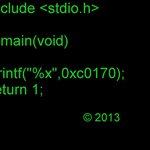mbed library sources
Dependents: Encrypted my_mbed lklk CyaSSL_DTLS_Cellular ... more
Superseded
This library was superseded by mbed-dev - https://os.mbed.com/users/mbed_official/code/mbed-dev/.
Development branch of the mbed library sources. This library is kept in synch with the latest changes from the mbed SDK and it is not guaranteed to work.
If you are looking for a stable and tested release, please import one of the official mbed library releases:
Import librarymbed
The official Mbed 2 C/C++ SDK provides the software platform and libraries to build your applications.
targets/hal/TARGET_Atmel/TARGET_SAM21/drivers/system/system.h
- Committer:
- mbed_official
- Date:
- 2015-07-17
- Revision:
- 592:a274ee790e56
- Parent:
- 579:53297373a894
File content as of revision 592:a274ee790e56:
#ifndef SYSTEM_H_INCLUDED
#define SYSTEM_H_INCLUDED
#include <compiler.h>
#include <clock.h>
#include <gclk.h>
#include <pinmux.h>
#include <power.h>
#include <reset.h>
#ifdef __cplusplus
extern "C" {
#endif
/**
* \defgroup asfdoc_sam0_system_group SAM System Driver (SYSTEM)
*
* This driver for Atmel庐 | SMART SAM devices provides an interface for the configuration
* and management of the device's system relation functionality, necessary for
* the basic device operation. This is not limited to a single peripheral, but
* extends across multiple hardware peripherals.
*
* The following peripherals are used by this module:
* \if DEVICE_SAML21_SUPPORT
* - PM (Power Manager)
* - RSTC(Reset Controller)
* - SUPC(Supply Controller)
* \else
* - SYSCTRL (System Control)
* - PM (Power Manager)
* \endif
*
* The following devices can use this module:
* \if DEVICE_SAML21_SUPPORT
* - Atmel | SMART SAM L21
* \else
* - Atmel | SMART SAM D20/D21
* - Atmel | SMART SAM R21
* - Atmel | SMART SAM D10/D11
* \endif
*
* The outline of this documentation is as follows:
* - \ref asfdoc_sam0_system_prerequisites
* - \ref asfdoc_sam0_system_module_overview
* - \ref asfdoc_sam0_system_special_considerations
* - \ref asfdoc_sam0_system_extra_info
* - \ref asfdoc_sam0_system_examples
* - \ref asfdoc_sam0_system_api_overview
*
*
* \section asfdoc_sam0_system_prerequisites Prerequisites
*
* There are no prerequisites for this module.
*
*
* \section asfdoc_sam0_system_module_overview Module Overview
*
* The System driver provides a collection of interfaces between the user
* application logic, and the core device functionality (such as clocks, reset
* cause determination, etc.) that is required for all applications. It contains
* a number of sub-modules that control one specific aspect of the device:
*
* - System Core (this module)
* - \ref asfdoc_sam0_system_clock_group "System Clock Control" (sub-module)
* - \ref asfdoc_sam0_system_interrupt_group "System Interrupt Control" (sub-module)
* - \ref asfdoc_sam0_system_pinmux_group "System Pin Multiplexer Control" (sub-module)
*
*
* \if DEVICE_SAML21_SUPPORT
* \subsection asfdoc_sam0_system_module_overview_vreg Voltage Regulator
* The SAM device controls the voltage regulators for the core (VDDCORE) and
* backup (VDDBU) domains. It sets the voltage regulators according to the sleep
* modes, the performance level, or the user configuration.
*
* In active mode, the voltage regulator can be chosen on the fly between a LDO
* or a Buck converter.In standby mode, the low power voltage regulator is used
* to supply VDDCORE.
*
* \subsection asfdoc_sam0_system_module_overview_bbps Battery Backup Power Switch
* The SAM device supports connection of a battery backup to the VBAT power pin.
* It includes functionality that enables automatic power switching between main
* power and battery backup power. This will ensure power to the backup domain,
* when the main battery or power source is unavailable.
* \endif
*
* \subsection asfdoc_sam0_system_module_overview_vref Voltage References
* The various analog modules within the SAM devices (such as AC, ADC, and
* DAC) require a voltage reference to be configured to act as a reference point
* for comparisons and conversions.
*
* The SAM devices contain multiple references, including an internal
* temperature sensor, and a fixed band-gap voltage source. When enabled, the
* associated voltage reference can be selected within the desired peripheral
* where applicable.
*
* \subsection asfdoc_sam0_system_module_overview_reset_cause System Reset Cause
* In some applications there may be a need to execute a different program
* flow based on how the device was reset. For example, if the cause of reset
* was the Watchdog timer (WDT), this might indicate an error in the application
* and a form of error handling or error logging might be needed.
*
* For this reason, an API is provided to retrieve the cause of the last system
* reset, so that appropriate action can be taken.
*
* \if DEVICE_SAML21_SUPPORT
* There are three groups of reset sources:
* - Power supply reset: Resets caused by an electrical issue. It covers POR and BODs reset.
* - User reset: Resets caused by the application. It covers external reset,
* system resetrequest and watchdog reset.
* - Backup reset: Resets caused by a backup mode exit condition.
*
* \subsection asfdoc_sam0_system_module_overview_performance_level Performance Level
* Performance level allows use to adjust the regulator output voltage to reduce
* power consumption. The user can select on the fly the performance level
* configuration which best suits its application.
*
* The SAM device embeds up to three performance level (PL0, PL1 and PL2).
* Each performance level defines a maximum frequency and a corresponding
* consumption in 渭A/MHz,when the application selects a new performance level,
* the voltage applied on the full logic area moves from a value to another,
* it can reduce the active consumption while decreasing the maximum frequency
* of the device.
*
* Performance level transition is possible only when the device is in active
* mode, after a reset, the device starts in the lowest performance level
* (lowest power consumption and lowest max. frequency). The application can then
* switch to another performance level at anytime without any stop in the code
* execution. As shown in \ref asfdoc_sam0_system_performance_level_transition_figure.
*
* \note When scaling down the performance level,the bus frequency should be first
* scaled down in order to not exceed the maximum frequency allowed for the
* low performance level.
* When scaling up the performance level (for example from PL0 to PL2), the bus
* frequency can be increased only once the performance level transition is
* completed,check the performance level status.
*
* \anchor asfdoc_sam0_system_performance_level_transition_figure
* \image html performance_level_transition.gif "The performance level transition"
*
* \subsection asfdoc_sam0_system_module_overview_power_domain Power Domain Gating
* Power domain gating can turn on or off power domain voltage to save power
* while keeping other domain powered up. It can be used in standby sleep mode,
* in standby mode, when power-gated, the internal state of the logic can be
* retained allowing the application context to be kept.
*
* Power domain can be in three states:
* - Active state: the power domain is powered on.
* - Retention state: the main voltage supply for the power domain is switched off,
* while maintaining a secondary low-power supply for the sequential cells. The
* logic context is restored when waking up.
* - Off state: the power domain is entirely powered off. The logic context is lost.
*
* The SAM L21 device has three power domains: PD0, PD1 and PD2.
* - By default, a power domain is set automatically to retention state in standby
* sleep mode if no activity is required in it, the application can force all power
* domains to remain in active state during standby sleep mode in order to accelerate
* wakeup time.
* - Static Power_SleepWalking: When entering standby mode, if a peripheral needs to
* remain in run mode to perform sleepwalking task, its power domain (PDn) remains in
* active state as well as the inferior power domains (<PDn).
* - Dynamic Power_SleepWalking: During standby mode, a power domain (PDn) in active
* state (using the static Power_SleepWalking principle), can wakeup a superior power
* domain (>PDn) in order to perform a sleepwalking task. The superior power domain is
* then automatically set to active state. At the end of the sleepwalking task, either
* the device can be waken-up or the superior power domain can be set again to retention
* state.
*
* Power domains can be linked each other,it allows a power domain (PDn) to be kept
* in active state if the inferior power domain (PDn-1) is in active state too.
*
* The table \ref asfdoc_sam0_system_power_domain_overview_table illustrates the
* four cases to consider in standby mode
*
* \anchor asfdoc_sam0_system_power_domain_overview_table
* <table>
* <caption>Sleep Mode versus Power Domain State Overview</caption>
* <tr>
* <th>Sleep mode</th>
* <th></th>
* <th>PD0</th>
* <th>PD1</th>
* <th>PD2</th>
* <th>PDTOP</th>
* <th>PDBACKUP</th>
* </tr>
* <tr>
* <td>IDLE</td>
* <td></td>
* <td>active</td>
* <td>active</td>
* <td>active</td>
* <td>active</td>
* <td>active</td>
* </tr>
* <tr>
* <td>Standby</td>
* <td>Case 1</td>
* <td>active</td>
* <td>active</td>
* <td>active</td>
* <td>active</td>
* <td>active</td>
* </tr>
* <tr>
* <td>Standby</td>
* <td>Case 2</td>
* <td>active</td>
* <td>active</td>
* <td>retention</td>
* <td>active</td>
* <td>active</td>
* </tr>
* <tr>
* <td>Standby</td>
* <td>Case 3</td>
* <td>active</td>
* <td>retention</td>
* <td>retention</td>
* <td>active</td>
* <td>active</td>
* </tr>
* <tr>
* <td>Standby</td>
* <td>Case 4</td>
* <td>retention</td>
* <td>retention</td>
* <td>retention</td>
* <td>active</td>
* <td>active</td>
* </tr>
* <tr>
* <td>Backup</td>
* <td></td>
* <td>OFF</td>
* <td>OFF</td>
* <td>OFF</td>
* <td>OFF</td>
* <td>active</td>
* </tr>
* <tr>
* <td>Off</td>
* <td></td>
* <td>OFF</td>
* <td>OFF</td>
* <td>OFF</td>
* <td>OFF</td>
* <td>OFF</td>
* </tr>
* </table>
*
* \subsection asfdoc_sam0_system_module_overview_ram_state RAMs Low Power Mode
* By default, in standby sleep mode, RAM is in low power mode (back biased)
* if its power domain is in retention state.
* The table \ref asfdoc_sam0_system_power_ram_state_table lists RAMs low power mode.
*
* \anchor asfdoc_sam0_system_power_ram_state_table
* <table>
* <caption>RAM Back-biasing mode</caption>
* <tr>
* <th>RAM mode</th>
* <th>Description</th>
* </tr>
* <tr>
* <td>Retention Back-biasing mode</td>
* <td>RAM is back-biased if its power domain is in retention mode</td>
* </tr>
* <tr>
* <td>Standby Back-biasing mode</td>
* <td>RAM is back-biased if the device is in standby mode</td>
* </tr>
* <tr>
* <td>Standby OFF mode</td>
* <td>RAM is OFF if the device is in standby mode</td>
* </tr>
* <tr>
* <td>Always OFF mode</td>
* <td>RAM is OFF if the device is in RET mode</td>
* </tr>
* </table>
*
* \endif
*
* \subsection asfdoc_sam0_system_module_overview_sleep_mode Sleep Modes
* The SAM devices have several sleep modes, where the sleep mode controls
* which clock systems on the device will remain enabled or disabled when the
* device enters a low power sleep mode.
* \ref asfdoc_sam0_system_module_sleep_mode_table "The table below" lists the
* clock settings of the different sleep modes.
*
* \anchor asfdoc_sam0_system_module_sleep_mode_table
* <table>
* <caption>SAM Device Sleep Modes</caption>
* \if DEVICE_SAML21_SUPPORT
* <tr>
* <th>Sleep mode</th>
* <th>System clock</th>
* <th>CPU clock</th>
* <th>AHB/AHB clock</th>
* <th>GCLK clocks</th>
* <th>Oscillators (ONDEMAND = 0)</th>
* <th>Oscillators (ONDEMAND = 1)</th>
* <th>Regulator mode</th>
* <th>RAM mode</th>
* </tr>
* <tr>
* <td>IDLE</td>
* <td>Run</td>
* <td>Stop</td>
* <td>Run if requested</td>
* <td>Run</td>
* <td>Run</td>
* <td>Run if requested</td>
* <td>Normal</td>
* <td>Normal</td>
* </tr>
* <tr>
* <td>Standby</td>
* <td>Stop</td>
* <td>Stop</td>
* <td>Run if requested</td>
* <td>Run if requested</td>
* <td>Run if requested or RUNSTDBY = 1</td>
* <td>Run if requested</td>
* <td>Low pwer</td>
* <td>Low pwer</td>
* </tr>
* <tr>
* <td>Backup</td>
* <td>Stop</td>
* <td>Stop</td>
* <td>Stop</td>
* <td>Stop</td>
* <td>Stop</td>
* <td>Stop</td>
* <td>Backup</td>
* <td>OFF</td>
* </tr>
* <tr>
* <td>Off</td>
* <td>OFF</td>
* <td>OFF</td>
* <td>OFF</td>
* <td>OFF</td>
* <td>OFF</td>
* <td>OFF</td>
* <td>OFF</td>
* <td>OFF</td>
* </tr>
* \else
* <tr>
* <th>Sleep mode</th>
* <th>CPU clock</th>
* <th>AHB clock</th>
* <th>APB clocks</th>
* <th>Clock sources</th>
* <th>System clock</th>
* <th>32KHz</th>
* <th>Reg mode</th>
* <th>RAM mode</th>
* </tr>
* <tr>
* <td>IDLE 0</td>
* <td>Stop</td>
* <td>Run</td>
* <td>Run</td>
* <td>Run</td>
* <td>Run</td>
* <td>Run</td>
* <td>Normal</td>
* <td>Normal</td>
* </tr>
* <tr>
* <td>IDLE 1</td>
* <td>Stop</td>
* <td>Stop</td>
* <td>Run</td>
* <td>Run</td>
* <td>Run</td>
* <td>Run</td>
* <td>Normal</td>
* <td>Normal</td>
* </tr>
* <tr>
* <td>IDLE 2</td>
* <td>Stop</td>
* <td>Stop</td>
* <td>Stop</td>
* <td>Run</td>
* <td>Run</td>
* <td>Run</td>
* <td>Normal</td>
* <td>Normal</td>
* </tr>
* <tr>
* <td>STANDBY</td>
* <td>Stop</td>
* <td>Stop</td>
* <td>Stop</td>
* <td>Stop</td>
* <td>Stop</td>
* <td>Stop</td>
* <td>Low Power</td>
* <td>Source/Drain biasing</td>
* </tr>
* \endif
* </table>
*
* To enter device sleep, one of the available sleep modes must be set, and the
* function to enter sleep called. The device will automatically wake up in
* response to an interrupt being generated or other device event.
*
* Some peripheral clocks will remain enabled during sleep, depending on their
* configuration; if desired, modules can remain clocked during sleep to allow
* them to continue to operate while other parts of the system are powered down
* to save power.
*
*
* \section asfdoc_sam0_system_special_considerations Special Considerations
*
* Most of the functions in this driver have device specific restrictions and
* caveats; refer to your device datasheet.
*
*
* \section asfdoc_sam0_system_extra_info Extra Information
*
* For extra information, see \ref asfdoc_sam0_system_extra. This includes:
* - \ref asfdoc_sam0_system_extra_acronyms
* - \ref asfdoc_sam0_system_extra_dependencies
* - \ref asfdoc_sam0_system_extra_errata
* - \ref asfdoc_sam0_system_extra_history
*
*
* \section asfdoc_sam0_system_examples Examples
*
* For SYSTEM module related examples, refer to the sub-modules listed in
* the \ref asfdoc_sam0_system_module_overview "system module overview".
*
* \if DEVICE_SAML21_SUPPORT
* For a list of examples related to this driver, see
* \ref asfdoc_sam0_drivers_power_exqsg.
* \endif
*
*
* \section asfdoc_sam0_system_api_overview API Overview
* @{
*/
/**
* \name System Debugger
* @{
*/
/**
* \brief Check if debugger is present.
*
* Check if debugger is connected to the onboard debug system (DAP).
*
* \return A bool identifying if a debugger is present.
*
* \retval true Debugger is connected to the system
* \retval false Debugger is not connected to the system
*
*/
static inline bool system_is_debugger_present(void)
{
return DSU->STATUSB.reg & DSU_STATUSB_DBGPRES;
}
/**
* @}
*/
/**
* \name System Identification
* @{
*/
/**
* \brief Retrieve the device identification signature.
*
* Retrieves the signature of the current device.
*
* \return Device ID signature as a 32-bit integer.
*/
static inline uint32_t system_get_device_id(void)
{
return DSU->DID.reg;
}
/**
* @}
*/
/**
* \name System Initialization
* @{
*/
void system_init(void);
/**
* @}
*/
/**
* @}
*/
/**
* \page asfdoc_sam0_drivers_power_exqsg Examples for Power Driver
*
* This is a list of the available Quick Start Guides (QSGs) and example
* applications. QSGs are simple examples with step-by-step instructions to
* configure and use this driver in a selection of
* use cases. Note that QSGs can be compiled as a standalone application or be
* added to the user application.
*
* - \subpage asfdoc_sam0_power_basic_use_case
*
* \page asfdoc_sam0_system_extra Extra Information for SYSTEM Driver
*
* \section asfdoc_sam0_system_extra_acronyms Acronyms
* Below is a table listing the acronyms used in this module, along with their
* intended meanings.
*
* <table>
* <tr>
* <th>Acronym</th>
* <th>Definition</th>
* </tr>
* <tr>
* <td>PM</td>
* <td>Power Manager</td>
* </tr>
* \if DEVICE_SAML21_SUPPORT
* <tr>
* <td>SUPC</td>
* <td>Supply Controller</td>
* </tr>
* <tr>
* <td>RSTC</td>
* <td>Reset Controller</td>
* </tr>
* \else
* <tr>
* <td>SYSCTRL</td>
* <td>System control interface</td>
* </tr>
* \endif
* </table>
*
*
* \section asfdoc_sam0_system_extra_dependencies Dependencies
* This driver has the following dependencies:
*
* - None
*
*
* \section asfdoc_sam0_system_extra_errata Errata
* There are no errata related to this driver.
*
*
* \section asfdoc_sam0_system_extra_history Module History
* An overview of the module history is presented in the table below, with
* details on the enhancements and fixes made to the module since its first
* release. The current version of this corresponds to the newest version in
* the table.
*
* <table>
* <tr>
* <th>Changelog</th>
* </tr>
* \if DEVICE_SAML21_SUPPORT
* <tr>
* <td>Initial Release</td>
* </tr>
* \else
* <tr>
* <td>Added low power features and support for SAML21</td>
* </tr>
* <tr>
* <td>Added support for SAMD21</td>
* </tr>
* <tr>
* <td>Added new \c system_reset() to reset the complete MCU with some exceptions</td>
* </tr>
* <tr>
* <td>Added new \c system_get_device_id() function to retrieved the device
* ID.</td>
* </tr>
* <tr>
* <td>Initial Release</td>
* </tr>
* \endif
* </table>
*
* \page asfdoc_sam0_system_document_revision_history Document Revision History
*
* <table>
* <tr>
* <th>Doc. Rev.</td>
* <th>Date</td>
* <th>Comments</td>
* </tr>
* \if DEVICE_SAML21_SUPPORT
* <tr>
* <td>A</td>
* <td>12/2014</td>
* <td>Initial release.</td>
* </tr>
* \else
* <tr>
* <td>D</td>
* <td>12/2014</td>
* <td>Added support for SAMR21 and SAMD10/D11.</td>
* </tr>
* <tr>
* <td>C</td>
* <td>01/2014</td>
* <td>Added support for SAMD21.</td>
* </tr>
* <tr>
* <td>B</td>
* <td>06/2013</td>
* <td>Corrected documentation typos.</td>
* </tr>
* <tr>
* <td>A</td>
* <td>06/2013</td>
* <td>Initial release</td>
* </tr>
* \endif
* </table>
*/
#ifdef __cplusplus
}
#endif
#endif /* SYSTEM_H_INCLUDED */
 mbed official
mbed official





